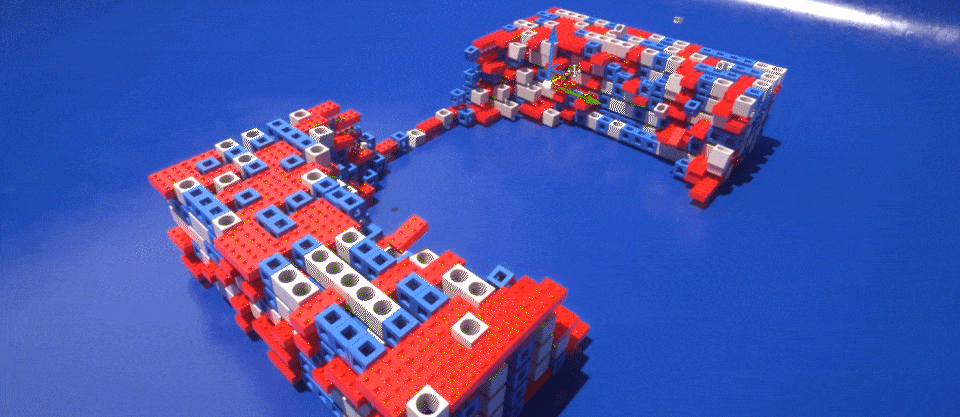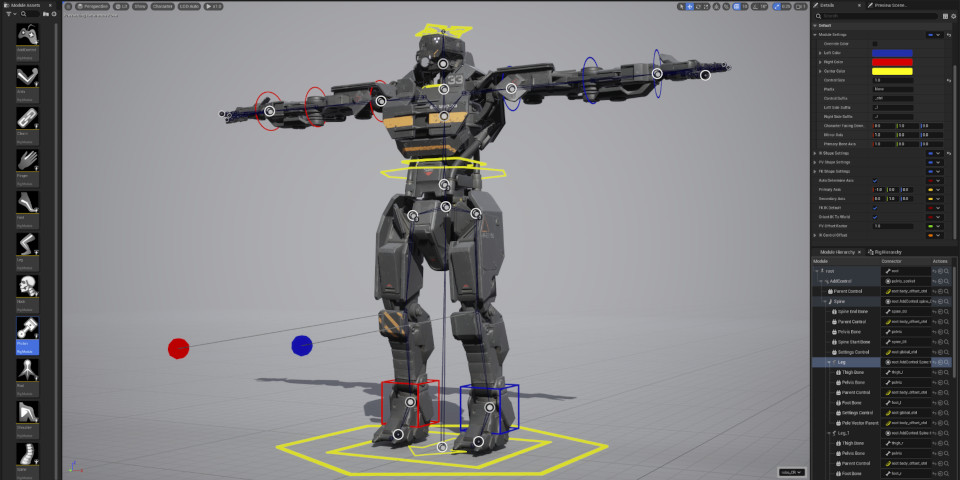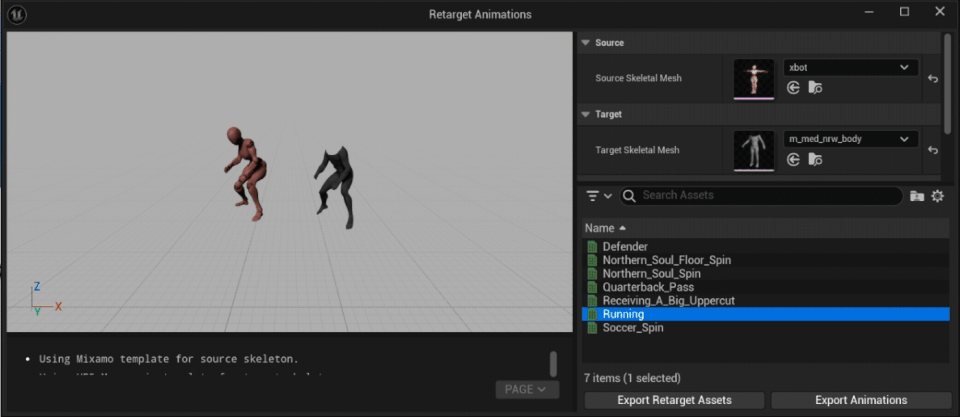Unreal Engine 5.4: five key features for CG artists
Epic Games has released Unreal Engine 5.4, the latest version of the game engine.
It’s another huge update, adding a complete new Motion Graphics Mode for motion design work, a new modular character rigging system, and automatic animation retargeting.
There are also updates to the virtual production tools, to offline rendering workflows for visual effects and animation, to Nanite geometry streaming, and to Unreal Engine’s physics toolsets.
Below, you can read our pick of the five main new features in Unreal Engine 5.4 for CG artists, as opposed to programmers, along with a summary of the other key changes.

1. Motion design: a complete new Motion Graphics Mode
By far the largest new toolset in Unreal Engine 5.4 is the new Motion Graphics Mode.
It provides a pretty comprehensive-looking set of features aimed at one of the few sectors of the CG industry that Epic Games hasn’t targeted so far, Unreal Engine having now been widely adopted for animation, VFX, virtual production and visualization as well as game development.
Described as having been developed “in conjunction with leading broadcasters”, Motion Graphics Mode combines features that will be familiar to motion designers used to offline tools like Cinema 4D’s MoGraph toolset with features targeted at real-time broadcast graphics.
In the first category, artists get access to a range of 2D and 3D primitives, a SVG importer for importing vector art, and Geometry Modifiers for modifying geometry procedurally.
For duplicating assets, there are a set of Cloners built on top of Unreal Engine’s Niagara particle system, and sets of Effectors and Effector Forces to animate the clones.
There are also a lot of supporting features like viewport rulers and guides, object aligment tools, a layer-based material system, and updates to existing features like 3D text and the World Outliner to make them easier to use in motion graphics workflows.
In the second category, there are a range of features for controlling the playout of on-air graphics, including a new Broadcast Rundown tool and a Transition Logic system.

2. Character rigging: new modular control rig (Experimental)
Character artists get an experimental new Modular Control Rig system.
It is intended to make character rigging more intuitive, making it possible to create custom animation rigs directly in the viewport by linking together a set of modular components.
Users can create their own custom modules, but Unreal Engine 5.4 ships with its own library of readymade modules, accessible via a new Control Rig Modules plugin.
The online documentation shows modules for creating robotic and organic characters – both humanoids and creatures – including heads, spines, limbs, hands, feet, tentacles and tails.
Modules are linked via a system of Connectors and Sockets, and can be mirrored.
The workflow can be used on any Skeletal Mesh, and modular rigs work in the same way as regular control rigs in the viewport and Unreal Engine’s Sequencer animation editor.
There are also updates to existing rigging features, including better direct manipulation of control rigs in the viewport, and the Skeletal Editor getting better snapping for bones.

3. Animation: automatic animation retargeting for biped characters
Animators get a number of changes to Unreal Engine’s IK retargeting toolset, for transferring existing animations to characters with different bodily proportions.
The biggest is the new Auto Retargeting system, intended to make retargeting “common bipedal skeletons” more “accessible and consistent”.
It includes a new Auto Retarget Chains tool, which automatically generates retarget chains for a Skeletal Mesh character, and Auto Align, which aligns character poses based on the chains.
There are also a lot of workflow improvements to existing animation features, including redesigns of both the viewport animation gizmos and Unreal Engine’s Constraints system.
4. Rendering: new render graph and render layers system in the Movie Render Queue
For offline rendering, Unreal Engine’s Movie Render Queue gets a new node-based architecture.
The Movie Render Graph should make it easier to scale render settings from individual shots to entire sequences or shows, and provides new “developer-friendly entry points” for scripting.
There is also a new system of Render Layers in addition to the existing Render Passes.
Render Layers are intended for use with pass-based compositing workflows in VFX, animation and visualization, and are supported in both the Path Tracer and Deferred Renderer.
5. Virtual Production: new VR scouting toolkit (Experimental)
Unreal Engine 5.4 features a number of changes to the software’s previs and virtual production tools, but the most eye-catching is the experimental rework of the virtual scouting tools.
The toolset, which makes it possible to view, annotate and edit scenes in VR, now features a more intuitive UX design based on Unreal Engine 5.4’s new underlying XR Creative Framework.
In addition, Live Link VCAM, Epic’s iOS app for controlling a virtual camera inside Unreal Engine via a smartphone, has been renamed Unreal VCam, and is now available on Android.
A desktop Mac version with native Apple Silicon support is “coming soon”.
Other changes include more accurate depth of field for in-camera VFX and multi-GPU support for the inner frustum render of ICVFX cameras.
Updates to Nanite, physics, 3D modeling and viewport rendering
Nanite, the new virtualized geometry system introduced in Unreal Engine 5.0 gets a number of new features, including experimental support for runtime tessellation.
That makes it possible to modify Nanite meshes at runtime using a displacement map, and have Unreal Engine automatically tessellate the mesh to match the detail in the map.
Niagara, Unreal Engine’s particle-based effects system, gets a new Asset Browser, an experimental new set of Lightweight Emitters, and updates to Niagara Fluids.
Chaos Physics gets a new Visual Debugger tool.
The Panel Cloth Editor rolled out in Unreal Engine 5.3 gets a new USD import node, making it possible to import clothing simulations from Marvelous Designer.
And for character physics, an experimental Physics Based Character Movement system provides two-way physics-based interaction between a character and its environment.
For creating or editing 3D assets, Unreal Engine’s native 3D modeling tools get new beveling and edge extrusion options, and the UV editing tools get a new texel density tool.
There are also improvements to hardware ray tracing, with a speed boost of “roughly 15%” in the Path Tracer, and Vulkan now at feature parity with DirectX 12.
Pipeline integration and platform changes
Changes to file import and export include new options to customize FBX import, and full roundtripping of glTF files with other DCC applications.
Changes to USD workflow include support for UsdVol schema for volumetric assets, and support for geometry caches and nested skeletal data when exporting USD files.
Imported MaterialX materials are now represented better in Unreal Engine’s new Substrate material system, and OpenPBR shaders are now translated automatically.
Platform updates include experimental support for Lumen, Unreal Engine’s real-time GI system, on mobile devices; experimental support for Apple’s new Vision Pro XR headset; and support for pixel streaming in browser apps running on macOS as well as Windows and Linux.
For game designers and developers, there are also updates to the world building and audio toolsets, and new data caching features. You can find details via the links below.
New pricing model for non-games work
Unreal Engine 5.4 is also the first version of the software to cost money for use in visual effects, animation, previs, virtual production and visualization.
As part of a series of pricing changes to Epic Games’ products announced last month, studios with gross revenues over $1 million/year now pay $1,850/seat/year for non-games work.
Artists with revenue under $1 million/year can continue to use Unreal Engine for free.
Pricing for games work is unaffected, with Epic Games continuing to take 5% of the gross royalties after the first $1 million generated by a game.
System requirements and availability
Unreal Engine 5.4 is available now for 64-bit Windows, macOS and Linux.
For non-interactive content, the software is free to users with revenue under $1 million/year. For larger studios, subscriptions cost $1,850/seat/year, including Twinmotion and RealityCapture.
For games developed with the engine, Epic takes 5% of the gross royalties after the first $1 million generated.
Read an overview of the new features in Unreal Engine 5.4 on Epic Games’ blog
Read a full list of new features in Unreal Engine 5.4 in the online release notes
Read Epic Games’ FAQs about the new pricing for Unreal Engine
Have your say on this story by following CG Channel on Facebook, Instagram and X (formerly Twitter). As well as being able to comment on stories, followers of our social media accounts can see videos we don’t post on the site itself, including making-ofs for the latest VFX movies, animations, games cinematics and motion graphics projects.
